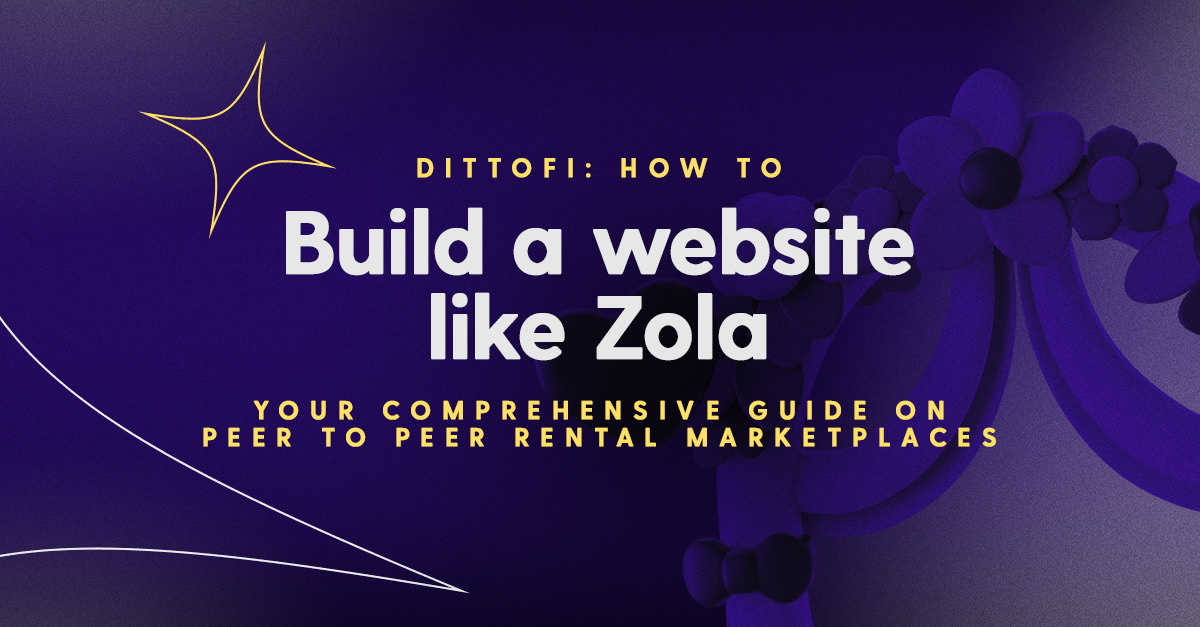The average American couple is engaged for 14 months and spends over $31,000 on their wedding. This makes wedding planning a high stakes game.
Throw in the tension that often comes when merging two families together and you get a mess of stress, complex logistics and social pressure.
Zola Weddings is a free suite of tools that couples use to make planning their wedding easier. The platform has successfully helped transform a fragmented marketplace of wedding service providers and products into a user-friendly system where couples can seamlessly find providers and manage all aspects of their wedding planning in one place.
In this article we will teach you everything that you need to know in order to create a website like Zola.
This includes:
- How was Zola founded?
- How Zola validated their product idea
- Features, descriptions and screenshots of Zola’s MVP.
- A detailed look at how Zola’s business model works.
- How Zola built their technology and found their first customers.
- How Zola raised capital and scaled usage.
But… before we get into all of that, let’s start by looking at what Zola actually is.
What is Zola?
Zola Weddings is an all in one wedding planning and registry platform that aims to simplify the wedding planning process for couples.
The platform works by offering access to a wide range of tools, products and services to help couples plan their dream wedding. This includes:
- An online wedding registry that couples can use to build a custom registry that includes products from top brands, experiences and cash and charity donations.
- A website builder that couples can use to create a personalized wedding website.
- Tools for guest list management i.e. sending digital save the date invitations, tracking RSVPs, and managing meal preference and seating arrangements.
- Checklist and planning tools to help couples stay organized throughout the wedding planning process. This includes timelines, budget trackers and vendor management tools.
- Curated directories of space and services providers such as photographers, venues, caterers, florists, and more. Couples can search these directories to find the perfect set of vendors that match their budget.
- Custom support options such as the choice to work with wedding planners to assist couples with planning their big day.
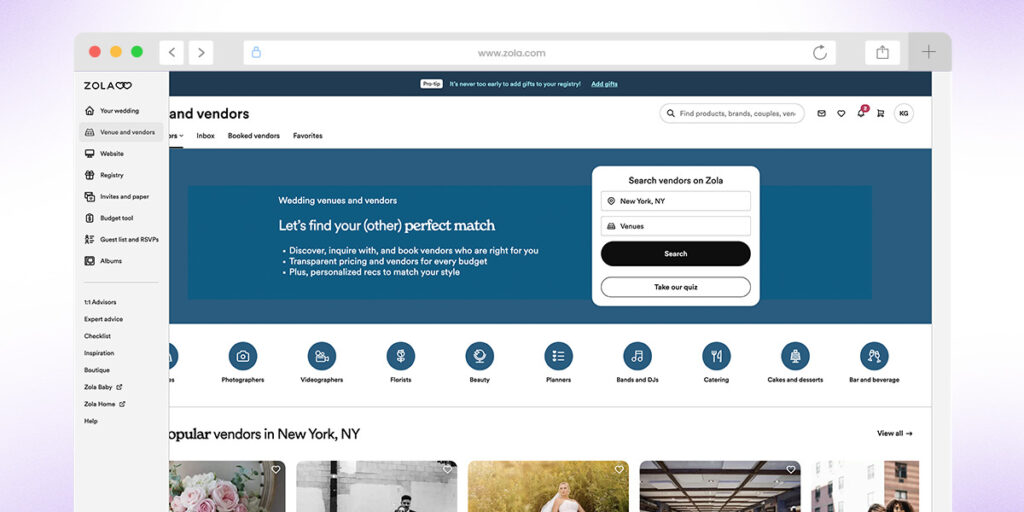
One of the things that makes Zola unique is the company’s business model.
Unlike traditional ecommerce stores, Zola does not hold any inventory or employ any service providers on payroll. Instead Zola acts as an online marketplace, connecting couples to products and service providers using a peer to peer marketplace and business to consumer marketplace model. These marketplaces are embedded inside of the Zola product, as shown below.
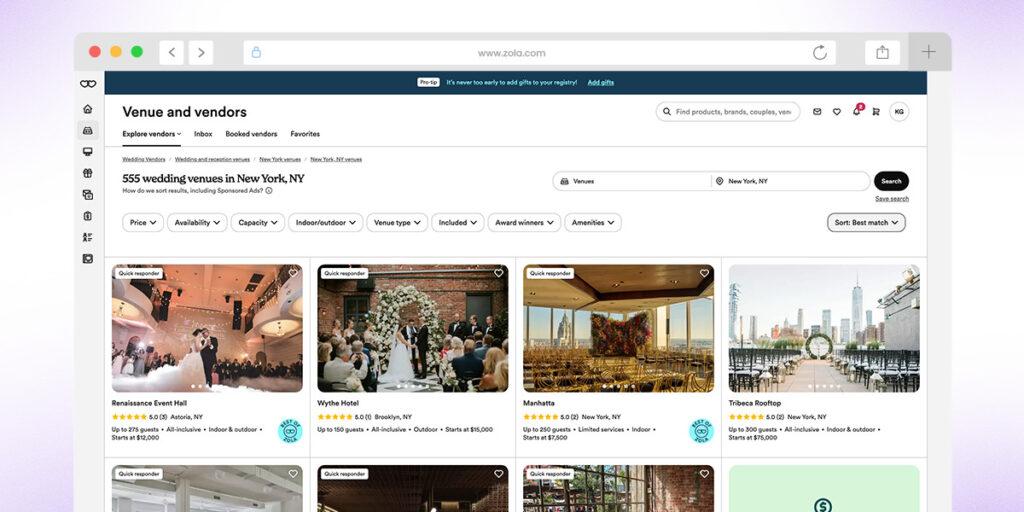
Do you want to build a website like Zola? Check out Dittofi’s peer to peer marketplace templates.
How Zola’s founders came up with the idea: Start small and grow
Zola was founded by Shan-Lyn Ma and Nobu Nakaguchi in 2013.
Like many successful startups, the idea for Zola was born out of a personal need.
As Shan-Lyn tells the story, everyone has a year in their life where all of their best friends are getting married. This year can be enormous fun, however it’s also very busy and expensive for couples and their friends.
On the one hand couples need to dedicate huge amounts of time to plan their weddings. On the other hand, guests need to make time to attend the weddings and buy gifts for their friends who are getting married.
For couples, wedding planning can be massively stressful. They must find time to meet and decide on bands, wedding venues, photographers, videographers, catering, cakes and desserts, send out invitations, manage guest lists, decide on seating… the list goes on and on.
Pre 2013, most couples stored all of this wedding information offline, in large wedding binders. However, this approach was dated. The new generation of millennial couples were searching for an online shopping experience that better fit their buying habits.
In the process of planning her own wedding, Shan-Lyn recognized that there was a gap in the market for an online, all-in-one wedding planning solution. She therefore set out on a mission to develop an all-in-one wedding planner, marketplace and advisor.
However… There was one major problem. Building an all in one wedding planning solution required a large amount of resources. Shan-Lyn knew she would need people to help with tech, marketing, sales, business development and so on. Shan-Lynn and her co-founder Nobu did not have the resources to do this and therefore, they decided to start by focusing on one niche and especially acute pain point within the wedding planning process.
This pain point was registering for gifts.
What was hard about registering for gifts in 2013
In 2013, traditional wedding registries were run by department stores like Macy’s, Bed Bath & Beyond, and Target. At this time, ecommerce was still a relatively new industry. Large department stores were hiring specialist consultants and software engineers in an effort to improve their general ecommerce capabilities.
Shan-Lyn herself was working as a product manager for a ecommerce company called Gilt Groupe. She recognized that whilst the big department stores were distracted by developing ecommerce capabilities for their core products, there was an opportunity to develop a specialist wedding gift registry solution that would rival the current solutions offered by department stores.
Let’s pause for a moment to remind ourselves what the department stores wedding registry solution was in 2013.
First, couples would need to physically visit a department store. Once at the department store the couples would be handed a barcode scanner. The couple would then walk through the store scanning items. Each item that the couple scanned would be automatically added to their wedding registry. The couple could then manage the registry online through the department store website, adding or removing items as needed.
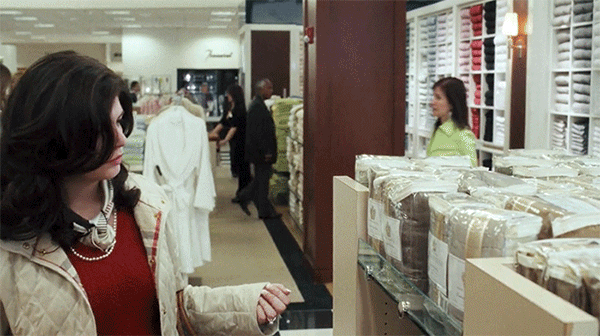
Once the registry had been created, guests could then visit the store, purchase an item off the registry, send it to the couple, or physically bring it to the wedding and gift it directly to the couple.
There are some quite obvious limitations with this process of registering and buying wedding gifts. These include:
- Limited selection: The couple would be limited to registering for gifts at a single department store. This experience doesn’t fly with millennials who are used to platforms like Amazon which give them a wide range of products to choose from.
- Inconvenience: Both the couple and the guest would need to physically visit the department stores to pick up the gift. For many people this could mean visiting the same department store 15 – 20 times in the same summer for each of their friends getting married.
- Limited online shopping: At the time, online shopping experiences were highly underdeveloped and so friends of the couple would often need to physically visit stores to make a purchase.
- Coordination challenges: Couples would have to manage and update the registry manually. This could lead to discrepancies between online and in store inventory, causing confusion for guests.
For more information on how to come up with your own idea for an online marketplace, read, how to come up with a great idea for an online marketplace.
Validating their product idea: Honing in on the problem
The problem and target audience seem clear. Couples need an online solution to register for gifts.

However, even though the problem and target audience seem fixed, Shan-Lyn and Nabou were both professional product managers. They therefore knew the dangers of diving headlong into coding a solution without first validating their idea and honing in on the pain points experienced by their target audience.
Zola’s founding team therefore set out to speak with as many people as they could about their product. Through hundreds of discussions, the founding team began to understand their target audience’s pain points in more detail. Shan-Lyn recalls that three things kept coming up.
- Couples really did want to register for gifts online
- Couples really do want to fully personalise their registry
- Couples wanted to control when their gifts were sent to them. In fact, most couples don’t actually want to receive gifts until after their wedding day and after their honeymoon.
Armed with this data, Shan-Lyn and Nabou started to design their minimum viable product MVP.
For more information on how to validate your marketplace idea, read how to validate your marketplace idea.
Designing their MVP: Waiting for the magic product question
“The magic question in the product world is ‘when can I use this product’?”
Shan-Lyn, Co-Founder of Zola.
As experienced product managers Shan-Lyn and Nabou know how much it can cost to build a product and how easy it is to build the wrong thing. They therefore began by designing prototypes of their product. These prototypes were detailed visual representations of the product’s user interface and functionality, also known as high fidelity wireframes.
The co-founders then took these prototypes to their target audience and would ask them to walk through the designs. They then waited and tried very hard not to sell the customer. Instead they would wait for the bride and groom to ask the magic product question which is “when can I use this product”.
It can be really hard for founders, not to pitch to how great your product is, but by silently watching your target audience use the solution, you can gather a lot more information about if your audience actually likes what they see. Shan-Lyn and Nobu recall that it took months of updating their product wireframes before eventually couples getting married in the following year started to ask “will this be ready for my own wedding?”.
“It was only when we started to hear brides who were getting married the following year say to us, ‘will this be ready in time for my own wedding?’… That’s when we knew we had a winning product and that’s when we committed to doing it 100%.”
Shan-Lyn, Co-Founder of Zola
Choosing a business model that works
In an interview with the Y-Combinator, Shan-Lyn recalls there are many wedding startups that closed down during the years when Zola started to succeed. She attributes much of the success that Zola experienced during these years to the business model that Zola designed.
Zola’s business model was created based on Shan-Lyn’s experience working for the ecommerce company Gilt Groupe. In this role she had helped drive the growth of the business from $0 in revenue to over $600 million in revenue in only four years. As such, she had seen what had worked, why it had worked and she knew why Gilt had never been able to become a profitable and sustainable business.
Shan-Lyn highlights three silent killers for any ecommerce business. These are:
Let’s break down the challenge with each of these points and how Zola addressed them.
Inventory is expensive to store
One of the main challenges with traditional ecommerce is inventory management.
Traditional ecommerce stores need large warehouses full of products to sell. These are expensive to maintain and require specialist inventory management systems and personnel to ensure products that the customers purchase are available for shipping as soon as they’re purchased.
Zola addresses this problem by operating a B2C marketplace model whereby the company holds no inventory. Instead the platform integrates with third party ecommerce platforms like Amazon, Macy’s, Target and more niche providers. They then display products from these providers on their website, as shown below.
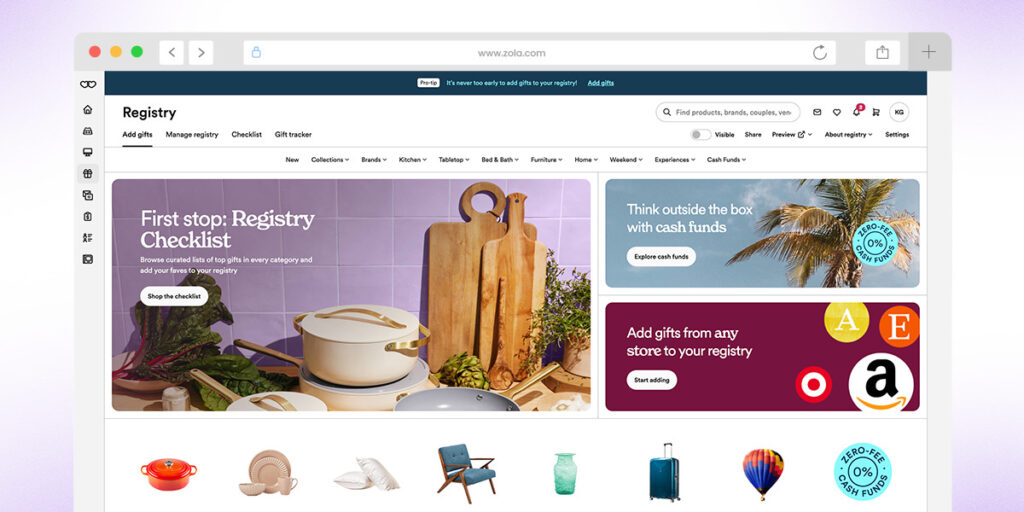
Using the product marketplace business model, Zola is much more capital efficient and is ultimately a more sustainable business compared to traditional ecommerce platforms.
Shan-Lyn was so effective at setting this system up because she had built good relationships with drop shipping companies during her time at Gilt. As such, Shan-Lyn contacted the companies she already knew and planned out a path to integrate Zola with these platform APIs. This would allow Zola to pull and display their product catalogues onto her marketplace. She then charged a transaction fee to connect up the product suppliers with the couples.
In this case, Shan-Lyn is the vendor of record. This means that she is responsible for handling customer complaints, returns and all aspects of customer service associated with the products purchased through Zola. So whilst Zola does not need to own or store any inventory, it does lead us to the next problem with traditional ecommerce, returns… the silent ecommerce killer.
To replicate this model you can use Dittofi’s web services technology which allows you to integrate with any third party API. Book a call to learn how to connect a drop shipping supplier to your online marketplace.
Returns - the silent killer in ecommerce
According to a study by Appriss Retail and the National Retail Foundation, more than 200 billion dollars (~180 billion GBP) worth of merchandise was returned in 2021, amounting to approximately 20% of total online sales.
Returns cost businesses about 66% of the original item’s price. Even if the item is returned in good condition, the entire returns process will still be costly because of the required labour, transport, and inspection (the business usually shoulders the return cost).
The cost of returns to the business can be broken down into the following points.
- Loss of customers
- Damage to brand and reputation
- Higher spend on acquiring new customers
- Lower lifetime value
In the case of Zola, they use the wedding registry concept to their advantage. As we have already seen, most couples do not want to receive the gifts until after their wedding and after their honeymoon. Therefore, Zola does not ship absolutely anything until the couple actually confirms that they want the product. Couples are also able to review their list of gifts and do virtual exchanges to purchase other big-ticket items, or they can keep their gifts.
This strategy means that “Zola gets virtually no returns” says Shan-Lyn, “both those things are often the killers of most ecommerce businesses”.
Forecasts and predictions
Getting people who are interested in the products listed on your site to actually checkout and buy the products in a predictable way is hard. It is known as building an “ecommerce funnel”, since if 10,000 people come into your website only a fraction of them will actually view the products, still less of them will add a product to their shopping cart and even less will actually purchase the product. This forms the shape of a funnel, as shown below.
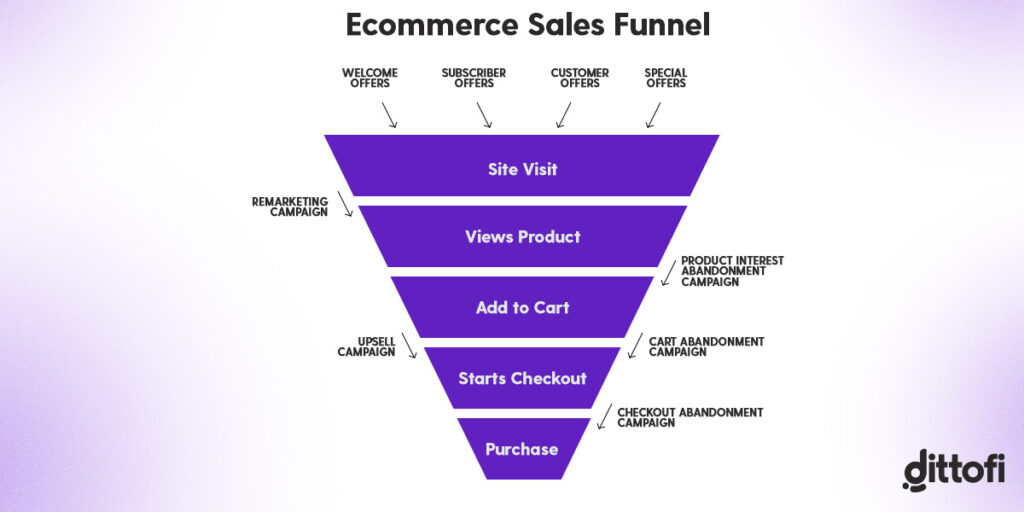
Getting people to go through a sales funnel is something that Shan-Lyn had specialized in at Gilt Groupe and she knew just how hard it was. Essentially it involves thinking of ways to incentivize demand to make a decision and actually purchase a product.
There are various tricks that you can use to incentivize your demand to actually make a decision. One of the best tactics is to make the people inside your funnel a time bound offer. For example, you might make an offer like everything will be 20% off for the next 24 hours. As an ecommerce store, you want the demand to be forecastable since this makes the demand more manageable.
In the case of Zola, the demand flows naturally through the funnel in a very forecastable way. This is because when people get married, they have to pick a wedding registry, and when you go to a wedding registry, you have to buy off the registry. That creates a ready demand that is going to happen by a certain deadline, which is the date of the wedding. This means that the demand intent is built into the idea of a wedding registry. This makes demand easier to convert and forecast for a defined list of products that are listed out 7 – 12 months in advance.
Summary: Zola’s online marketplace business model
In summary, Zola decided to use an online marketplace business model. This model allowed them to overcome challenges experienced by traditional ecommerce stores. Furthermore, it allowed them to start their wedding registry business without needing to store any inventory. As we will see later on, this would also allow them to add many more services to their platform and eventually turn their solution into an all in one wedding planning solution.
For more information on how to build a business to consumer marketplace read, how to build a B2C marketplace.
Going all in: How to build a website like Zola
“We always wanted to become an all in one wedding planning tool however, Zola started as an online wedding registry for millennials.”
Shan-Lyn Ma, Co-Founder of Zola.
Now Zola had a winning set of product wireframes and a business model that made sense, the next step was to build the technology. There are three main ways to build a technology like Zola these are:
- Custom code
- Traditional no-code / low-code solutions
- Hybrid no-code platforms
Each of these solutions has their own pros and cons.
Custom code allows you to build a complete bespoke and custom user experience. However, it is very expensive and time consuming to develop and maintain. Typically you’re looking at investing somewhere between $50,000 – $250,000 just to get your MVP developed. It’s also very hard to find a development team with experience building an online marketplace technology from scratch.
If you’re thinking about going the route of custom code, read our article how to hire a marketplace developer for more insights here.
Traditional no-code platforms allow you to build your MVP faster than custom code however, these solutions are heavily limited and have a finite lifespan. Typically you will need to invest somewhere between $10,000 – $50,000 to hire a no-code developer. This developer can help you build your MVP. However, you will need to rebuild your product entirely from scratch after approximately 12 months. These solutions are only really good for prototype app development.
Hybrid no-code platforms are a good combination of traditional no-code and custom code. These solutions are a unique combination of traditional code and no-code, visual development tools. Using a hybrid no-code platform, you are able to build your solution 10x faster than coding, at a lower cost. These solutions can then transform your no-code designs into enterprise grade code that you can then access, edit and own giving you a fast time to market, combined with the flexibility and durability of custom code.
In the case of Zola, they began by developing their online registry using custom code. (The option for hybrid no-code was not available then otherwise the founding team may well have chosen to use one of these tools for an equivalent solution.)
A screenshot of version 1 of their product is shown below.
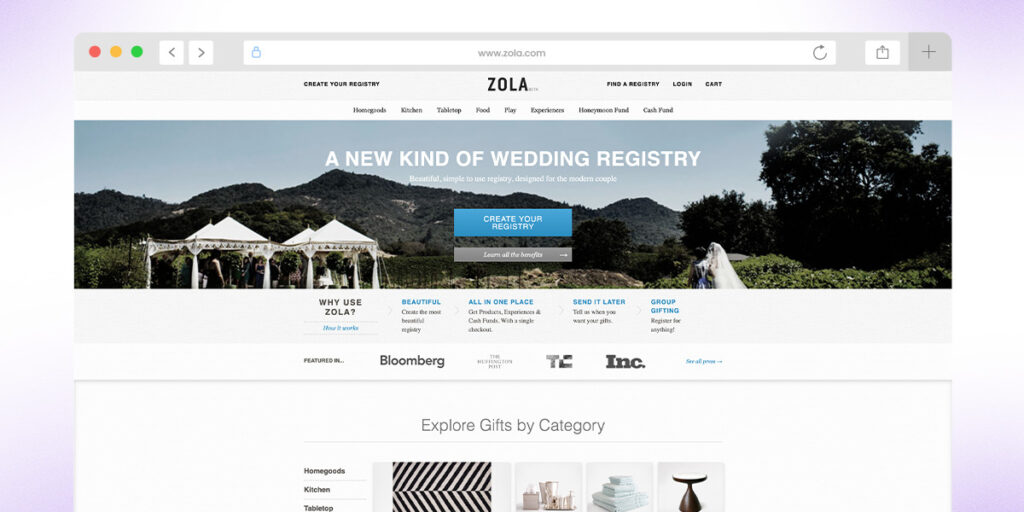
The platform was developed according to the prototypes that they had developed while designing their MVP which aimed to allow couples to fully personalize their registry with an easy to use website builder AND, give couples control over when they would receive their gifts.
Finally, Zola also allowed couples to:
- Exchange gifts online.
- Enabled group gifting.
- Allowed couples to register for gifts, experiences and funds.
How Zola found their first customers
At its core, Zola is a two sided marketplace. This means that the platform faces what is known as the marketplace chicken and egg problem.
Essentially this means that without couples visiting the marketplace, there is very little incentive for product vendors to sign up to the marketplace and list their products. Similarly, without products listed there is very little incentive for couples to visit the website in order to create a wedding registry.
As we have seen, Zola was able to solve the supply problem by integrating directly with drop shipping companies. This allowed them to pull products from these vendors and display them within their wedding registry. Shan-Lyn was helped here by her experience working for Gilt Groupe where she learnt how drop shipping worked and had already developed relationships with trusted drop shipping vendors.
Once Zola had integrated with these drop shipping vendors, the platform needed couples. To do this, the founders targeted the couples who had already expressed interest in their product. They had a list of more than 3000 couples who they had already surveyed and showed their platform to.
From here, the founders got sign ups and, as Shan-Lyn explained, for every couple they acquired, they got free publicity to the 100 people or so who were guests at the wedding, and that helped create a viral feedback look that spread the word about the platform.
Shan-Lyn and Nobu had, from the beginning, seen the registry as only one aspect of the whole wedding journey. Their mission was to help couples from the day they got engaged right through the whole wedding planning journey and into their first year of marriage.
Now they were armed with statistics from their initial success and a list of requests from couples asking for more features, Shan-Lyn approached her old boss at Gilt Groupe, Kevin Ryan and asked him if he would be interested in funding their company.
As we are about to see, this conversation brought the end of Zola’s fundraising journey and transformed the fastest growing online wedding platform.
“Right from the start our mission was to help couples from the day they get engaged through the whole wedding planning journey and into their first year of marriage.”
Shan-Lyn, Co-Founder of Zola.
How did Zola raise funding: The seed round
Shan-Lyn Ma previously worked at Gilt Groupe for a man named Kevin Ryan who was a serial entrepreneur living in New York City.
Shan-Lyn had been working with Kevin for 4 long years during which time she had helped his business grow from $0 in revenue to more than $600 million. This had helped her establish a very strong relationship with Kevin who was also very experienced in running ecommerce businesses.
Now, armed with a clearly defined target audience, a solid ecommerce business model and the first set of customers, Shan-Lyn was called Kevin and asked him if he would be interested in investing into her business.
Kevin agreed and was excited to work with Shan-Lyn again and gave her the seed funding to start scaling up her business. From there, Shan-Lyn and Nobu, started iterating on their product, working on increasing their customer acquisition, refining their business model, adding new products and services and growing their user base.
Zola’s business model: How does Zola make money
Zola generates revenue through ecommerce sales made on its platform. The solution is free to sign up and then Zola earns commissions and fees from products and services sold through its registry and vendor marketplaces. These commissions contribute to the company’s revenue stream, alongside advertising and partnership opportunities.
Whilst Zola started as a wedding website and tool to build a wedding registry, the solution now offers a range of products and services that can be used through.
In each case, Zola uses a marketplace business model where product and service providers are able to list their products, venues and services. Couples are then given an easy to use interface where they can search and find the products and services they need to help plan their wedding.
In exchange for booking services through Zola, the platform charges 20% commission (or take rate) of the total purchase price. This percentage doubles to 40% for physical product services and is set to 2.4% on cash gifts. The 2.4% cash gift is the lowest of its kind compared to fees of similar wedding services companies.
Using the commission based, marketplace business model, Zola avoids the costs of having to warehouse inventory. Furthermore, the platform does not need to own any wedding venues or offer any services directly. Their role is simply to connect couples with providers and help couples manage the wedding planning process with their suite of online tools.
Summary: How to build a website like Zola
To build a website like Zola, you need to first think of an idea.
It is best to start with a niche idea. You should then go deep into that niche. Understand your target audience. What are their pain points? Can you design a solution that alleviates their pain points? Can you list out these pain points into a concise bullet point list? This niche could be something simple like applying Zola’s wedding planning concept to a new geography or, it could mean targeting just one aspect of the wedding planning process that you believe you can do better.
After you’ve identified your target audience and their pain. Can you design a product that makes your target audience ask the magic product question: “when can I use this product”?
Armed with this information, you will next need to carefully think through the business model for your solution. Once you have identified a business model, the next step is to choose a technology to develop your solution with.
Finally, you will need to find customers.
Zola is a two sided marketplace and therefore the platform must find both product and service providers as well as couples. As we saw, Zola used a drop shipping model to get their initial product suppliers onto their platform.
To learn more about how to build a website like Zola, check out some of our related articles. You can also schedule a call with one of our marketplace experts who can explain how you can build a website like Zola today!
And… in case we don’t speak. Good luck in your business development journey!
Become a Marketplace Insider
Join our inner circle for exclusive insights, coveted trade secrets, and unparalleled strategies – your journey to marketplace dominance begins here.

